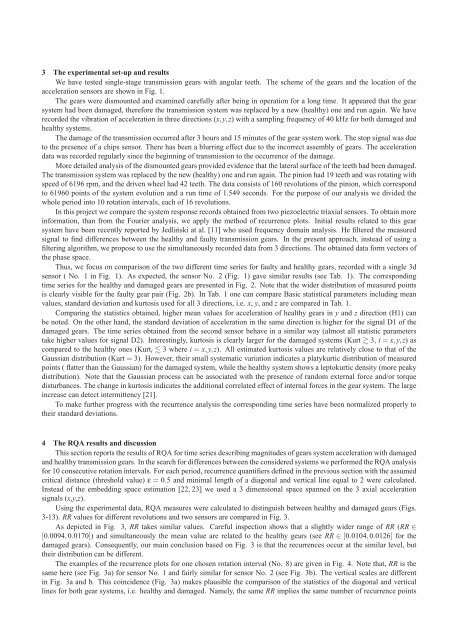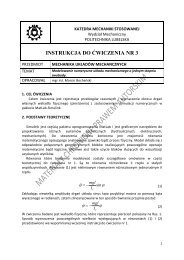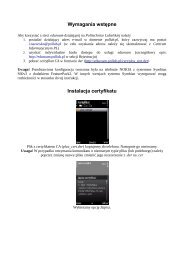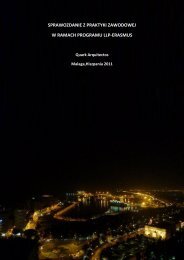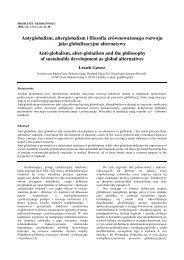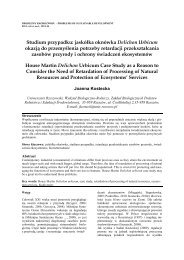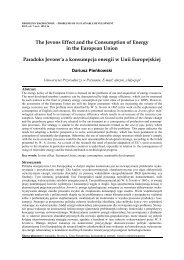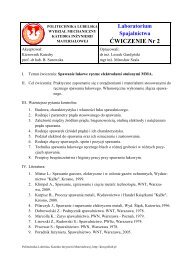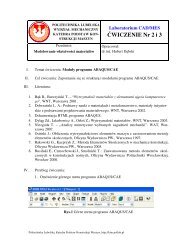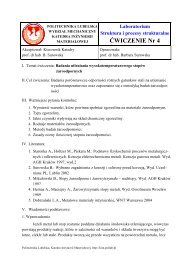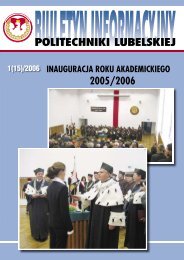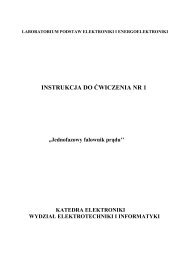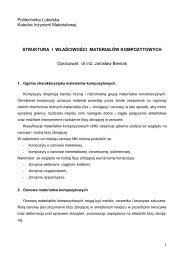pdf-preprint - Grzegorz Litak
pdf-preprint - Grzegorz Litak
pdf-preprint - Grzegorz Litak
You also want an ePaper? Increase the reach of your titles
YUMPU automatically turns print PDFs into web optimized ePapers that Google loves.
3 The experimental set-up and resultsWe have tested single-stage transmission gears with angular teeth. The scheme of the gears and the location of theacceleration sensors are shown in Fig. 1.The gears were dismounted and examined carefully after being in operation for a long time. It appeared that the gearsystem had been damaged, therefore the transmission system was replaced by a new (healthy) one and run again. We haverecorded the vibration of acceleration in three directions (x,y,z) with a sampling frequency of 40 kHz for both damaged andhealthy systems.The damage of the transmission occurred after 3 hours and 15 minutes of the gear system work. The stop signal was dueto the presence of a chips sensor. There has been a blurring effect due to the incorrect assembly of gears. The accelerationdata was recorded regularly since the beginning of transmission to the occurrence of the damage.More detailed analysis of the dismounted gears provided evidence that the lateral surface of the teeth had been damaged.The transmission system was replaced by the new (healthy) one and run again. The pinion had 19 teeth and was rotating withspeed of 6196 rpm, and the driven wheel had 42 teeth. The data consists of 160 revolutions of the pinion, which correspondto 61960 points of the system evolution and a run time of 1.549 seconds. For the purpose of our analysis we divided thewhole period into 10 rotation intervals, each of 16 revolutions.In this project we compare the system response records obtained from two piezoelectric triaxial sensors. To obtain moreinformation, than from the Fourier analysis, we apply the method of recurrence plots. Initial results related to this gearsystem have been recently reported by Jedliński at al. [11] who used frequency domain analysis. He filtered the measuredsignal to find differences between the healthy and faulty transmission gears. In the present approach, instead of using afiltering algorithm, we propose to use the simultaneously recorded data from 3 directions. The obtained data form vectors ofthe phase space.Thus, we focus on comparison of the two different time series for faulty and healthy gears, recorded with a single 3dsensor ( No. 1 in Fig. 1). As expected, the sensor No. 2 (Fig. 1) gave similar results (see Tab. 1). The correspondingtime series for the healthy and damaged gears are presented in Fig. 2. Note that the wider distribution of measured pointsis clearly visible for the faulty gear pair (Fig. 2b). In Tab. 1 one can compare Basic statistical parameters including meanvalues, standard deviation and kurtosis used for all 3 directions, i.e. x, y, and z are compared in Tab. 1.Comparing the statistics obtained, higher mean values for acceleration of healthy gears in y and z direction (H1) canbe noted. On the other hand, the standard deviation of acceleration in the same direction is higher for the signal D1 of thedamaged gears. The time series obtained from the second sensor behave in a similar way (almost all statistic parameterstake higher values for signal D2). Interestingly, kurtosis is clearly larger for the damaged systems (Kurt 3, i = x,y,z) ascompared to the healthy ones (Kurt i 3 where i = x,y,z). All estimated kurtosis values are relatively close to that of theGaussian distribution (Kurt = 3). However, their small systematic variation indicates a platykurtic distribution of measuredpoints ( flatter than the Gaussian) for the damaged system, while the healthy system shows a leptokurtic density (more peakydistribution). Note that the Gaussian process can be associated with the presence of random external force and/or torquedisturbances. The change in kurtosis indicates the additional correlated effect of internal forces in the gear system. The largeincrease can detect intermittency [21].To make further progress with the recurrence analysis the corresponding time series have been normalized properly totheir standard deviations.4 The RQA results and discussionThis section reports the results of RQA for time series describing magnitudes of gears system acceleration with damagedand healthy transmission gears. In the search for differences between the considered systems we performed the RQA analysisfor 10 consecutive rotation intervals. For each period, recurrence quantifiers defined in the previous section with the assumedcritical distance (threshold value) ε = 0.5 and minimal length of a diagonal and vertical line equal to 2 were calculated.Instead of the embedding space estimation [22, 23] we used a 3 dimensional space spanned on the 3 axial accelerationsignals (x,y,z).Using the experimental data, RQA measures were calculated to distinguish between healthy and damaged gears (Figs.3-13). RR values for different revolutions and two sensors are compared in Fig. 3.As depicted in Fig. 3, RR takes similar values. Careful inspection shows that a slightly wider range of RR (RR ∈[0.0094,0.0170]) and simultaneously the mean value are related to the healthy gears (see RR ∈ [0.0104,0.0126] for thedamaged gears). Consequently, our main conclusion based on Fig. 3 is that the recurrences occur at the similar level, buttheir distribution can be different.The examples of the recurrence plots for one chosen rotation interval (No. 8) are given in Fig. 4. Note that, RR is thesame here (see Fig. 3a) for sensor No. 1 and fairly similar for sensor No. 2 (see Fig. 3b). The vertical scales are differentin Fig. 3a and b. This coincidence (Fig. 3a) makes plausible the comparison of the statistics of the diagonal and verticallines for both gear systems, i.e. healthy and damaged. Namely, the same RR implies the same number of recurrence points


